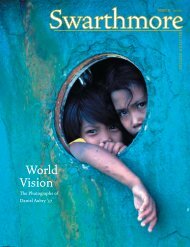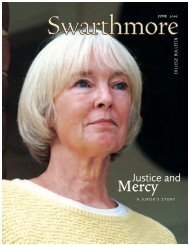Swarthmore College Bulletin (June 1998) - ITS
Swarthmore College Bulletin (June 1998) - ITS
Swarthmore College Bulletin (June 1998) - ITS
- No tags were found...
You also want an ePaper? Increase the reach of your titles
YUMPU automatically turns print PDFs into web optimized ePapers that Google loves.
A reversal of the heartAmy Verstappen ’83 is an adult survivor of a congenital heart defect.By Terri Pyer ’77One can hardly imagine words you’drather hear from your doctor than,“You’re fine, don’t worry.” For years,this is just what every doctor told AmyVerstappen ’83, despite her havingbeen born with a heart defect. And tobe fair, Amy was fine: She felt healthy,grew normally, and engaged in normalactivities. But in 1995, two years afterthe birth of her daughter, Amy washearing quite different words: “Yourheart has deteriorated so badly that theonly hope is a transplant.”“I just flipped out. My echocardiogramshowed that the valve was completelyshot and the heart muscle wasso damaged that the right ventricle wasnot working the way it should,”recounts Verstappen. “Everyone hadalways told me that I was going to befine. But it turns out that I was profoundlynot fine.”At birth doctors could tell that Amyhad a heart defect because her skinwas blue and she had a heart murmur.It was not until a catheterization wasperformed when she was 4 years oldthat the precise nature of her conditionwas discovered: congenitally correctedtransposition of the great arteries. “It’sas if someone took the lower half of myheart, my ventricles, and rotatedthem,” Verstappen explains.Approximately one of 125 babies isborn with a congenital heart problem.More than 100 types of defects exist,and some children are born with morethan one. About 10 percent have atransposition. When the transpositionis incomplete, blood moves throughthe body without ever making it to thelungs, and these patients need immediatesurgery or die soon after birth. Verstappen’scondition is called “congenitallycorrected” because the ventriclesand the valves are completely reversed,allowing blood to be oxygenated as itmoves through the system.In Verstappen’s case annual visits tocardiologists never revealed new problems.Some time after marrying RichardGilbertie ’82, Verstappen asked her doctorsabout the advisability of becomingpregnant. She was assured that herheart was fine and should not be affectedby a pregnancy. Lena Margaret Verstappenwas born in 1993.Two years later, when Verstappenand her husband were consideringadding to their family, Amy just didn’tTold that her only hope of survival was aheart transplant, Amy Verstappen ’83looked for another answer. She wentback to some of her old doctors, consultednew ones, and turned to the Internet.feel like herself; she had never regainedthe energy she had before her pregnancy.She returned to a doctor to inquireabout her fatigue and was eventuallygiven surprisingly bad news. She wastold she had dilated cardiomyopathy, aswelling and thinning of the heart muscle.Without a transplant, doctors toldher, she would die.How could this be? How could allher previous doctors have been sowrong? Verstappen sought answers.Many factors emerged to explainwhy Verstappen’s case had been mismanaged.When Verstappen became anadult and needed advice on matters offamily planning and adult health maintenance,few doctors could meet thoseneeds. Though the entire patient loadof pediatric cardiologists typically comprisescongenital cases, most adult cardiologistsdeal almost exclusively withnoncongenital cases. Until fairly recently,children with serious heart defectsusually did not survive into adulthood,so adult congenital cardiology was virtuallynonexistent. A new cardiologyspecialty is slowly emerging, but thereare obstacles to it.Verstappen says that the currentcompetitive model for the delivery ofAmerican medical care discourages thecreation of regional centers where suchexpertise can be concentrated.“If you see doctors who have fewcongenital patients,” Verstappenexplains, “there’s an extremely lowchance that they will ever have encounteredanyone with what you have.”In 1997, Verstappen was finally seenat two national adult congenital heartcenters—in Cleveland and at the MayoClinic in Minnesota—where she wastold to her great relief that the previousdiagnosis of dilated cardiomyopathywas incorrect. In fact, her heart couldstand surgery to replace a deterioratingvalve. She did not need a heart transplant—atleast for now.Amy Verstappen had successfulheart valve replacement surgery onMarch 15. “I feel like I have been giventhis huge gift, which is that I have 15 to20 years to not worry about dying. Ivalue my time in a different way. Ispend more time with my daughter andmy husband, and I have a more balancedlife. I tell people that this is thebest thing that ever happened to me,”says Verstappen.One of the saving graces for Verstappenwas the information and supportshe found on the Internet. “The Canadianhealth care system is light-yearsahead of us in regionalizing knowledgeand services, and the Canadian AdultCongenital Heart Network has a greatWeb site where I got a lot of information,”exclaims Verstappen. “Anotherthing that was really helpful was talkingto other heart defect patients on theInternet. Without the Internet I wouldhave gone through life without evermeeting another individual with thesame defect.”Her thoughts for others in her situation:“Be an advocate for yourself. Makesure that you are getting the best possiblecare. Know all you can about yourcondition. And get on the Internet.”Verstappen may need a transplantat some point in the future, but shesays “treatments change so rapidly.You just don’t know.” In the meantimeshe is working with others to create anational support and information networkto serve adults with congenitalheart defects.To join in an Internet conversation onadult congenital heart defects, send ane-mail message to majordomo@tchin.organd include as the subject “subscribeachd.” The Canadian Adult CongenitalHeart Network’s Web address is http://www.cachnet.org.JUNE <strong>1998</strong> 55
















